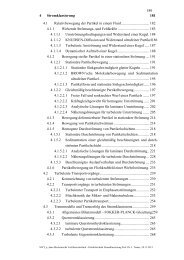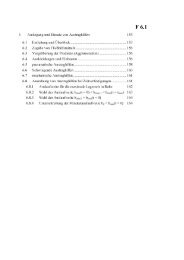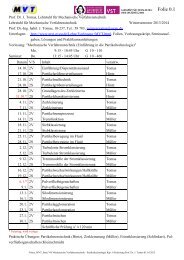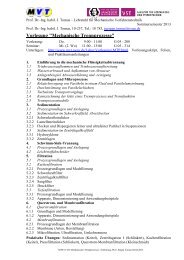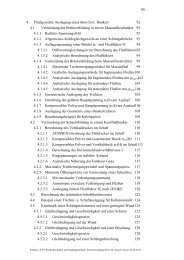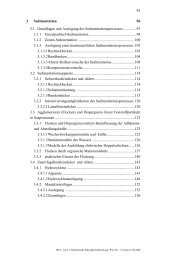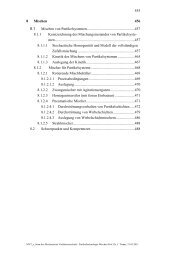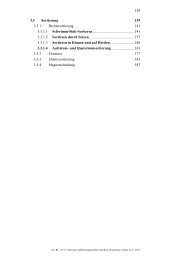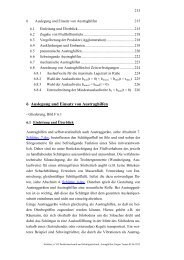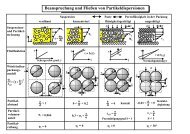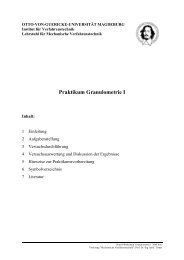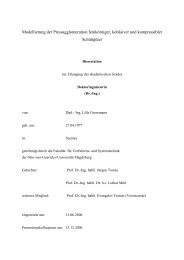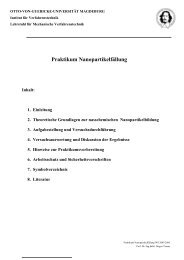Partikel- und Schüttgutmechanik - Lehrstuhl Mechanische ...
Partikel- und Schüttgutmechanik - Lehrstuhl Mechanische ...
Partikel- und Schüttgutmechanik - Lehrstuhl Mechanische ...
Sie wollen auch ein ePaper? Erhöhen Sie die Reichweite Ihrer Titel.
YUMPU macht aus Druck-PDFs automatisch weboptimierte ePaper, die Google liebt.
• Seine Abhängig von der Mittelpunktsspannung σM,st lässt sich durch<br />
Einsetzen der Gl.(3.84) des stationären Fließorte in Gl.( 3.97) zeigen:<br />
( σ + σ )<br />
sinϕ<br />
⎛ ⎞<br />
st ⋅ M,<br />
st 0<br />
σ<br />
= ϕ ⋅ ⎜ 0<br />
sin ϕ =<br />
⎟<br />
e<br />
sin st ⎜<br />
1 +<br />
σ<br />
⎟<br />
( 3.98)<br />
M,<br />
st<br />
⎝ σM,<br />
st ⎠<br />
• Daraus gewinnt man mit Hilfe der Gl.( 3.127)<br />
Übung<br />
σ + σ<br />
1 0<br />
σ M,<br />
st + σ0<br />
=<br />
( 3.127)<br />
1 + sinϕst<br />
⎛ σ1<br />
+ σ0<br />
⎞ ⎛ σ1<br />
+ σ0<br />
⎞<br />
⎜<br />
⎟ ⎜<br />
⎟<br />
⎜ 1+<br />
sinϕst<br />
⎟ ⎜ 1+<br />
sinϕst<br />
sin ϕ<br />
= ϕ ⋅<br />
⎟<br />
e = sinϕst<br />
⋅<br />
sin st<br />
⎜ σ1<br />
+ σ0<br />
⎟ ⎜ σ1<br />
+ σ0<br />
− σ0<br />
− σ0<br />
⋅sinϕst<br />
⎟<br />
⎜ − σ0<br />
⎟ ⎜<br />
⎟<br />
⎝ 1+<br />
sinϕst<br />
⎠ ⎝ 1+<br />
sinϕst<br />
⎠<br />
die Abhängigkeit des effektiven Reibungswinkels ϕe von der größten<br />
Hauptspannung σ1, siehe auch F 3.79:<br />
⎛ σ ⎞<br />
1 + σ0<br />
sin ϕ ⎜<br />
⎟<br />
e = sin ϕst<br />
⋅<br />
( 3.99)<br />
⎝ σ1<br />
− σ0<br />
⋅ sin ϕst<br />
⎠<br />
Herleitung der Gleichungen für<br />
a) einaxiale Druckfestigkeit σ = ( σ bzw.<br />
τ , ϕ ) = ?<br />
c f Z<br />
c i<br />
Z 1 = f ( σZ<br />
bzw.<br />
τc<br />
, ϕi<br />
)<br />
b) einaxiale Zugfestigkeit σ<br />
= ?<br />
c) Tangentialpunkt σTa des σc-Kreises<br />
Zu a) einaxialer Spannungszustand, d.h. σ2 = 0 in Gl. ( 3.62)<br />
2sinϕi<br />
2 cosϕi<br />
σ c = σ1=<br />
⋅ σZ<br />
=<br />
1−<br />
sinϕ<br />
1−<br />
sinϕ<br />
τc<br />
( 3.100)<br />
i<br />
Zu b) Zugbereich, d.h. negative σ σ 1 = 0 <strong>und</strong> σ2<br />
= σZ1<br />
2sinϕ<br />
i<br />
2 cosϕ<br />
i<br />
i<br />
σ Z1<br />
= σ2<br />
= − σZ<br />
= − σZ<br />
( 3.101)<br />
1+<br />
sinϕi<br />
1+<br />
sinϕi<br />
Zu c) Tangentialpunkt σTa des σc-Kreises, siehe Bild 3.16:<br />
Dreieckswinkel: sin ϕ i<br />
σM<br />
− σTa<br />
=<br />
σ<br />
σ<br />
Ta<br />
= σ<br />
M<br />
− σ<br />
R<br />
⋅sin<br />
ϕ<br />
i<br />
Für die einaxiale Druckfestigkeit ist σ2 = 0 damit σR = σM = σc/2:<br />
σc<br />
σc<br />
σc<br />
σ Ta = − ⋅ sin ϕi<br />
= ⋅ ( 1−<br />
sin ϕi<br />
)<br />
2 2 2<br />
Nach Einsetzen von Gl.( 3.100) für σc folgt:<br />
2 ⋅ τc<br />
⋅ cos ϕi<br />
σ Ta =<br />
2 ⋅ 1−<br />
sin ϕ<br />
⋅ 1−<br />
sin ϕi<br />
= τc<br />
⋅ cos ϕ<br />
( 3.102)<br />
( ) ( ) i<br />
i<br />
Die Strecke von τc (auf der τ-Achse) entlang des Fließortes um den<br />
Betrag τc verlängert ergibt den Tangentialpunkt σTa des σc-Kreises.<br />
Schüttec_3 VO <strong>Partikel</strong>mechanik <strong>und</strong> Schüttguttechnik, Kontakt- <strong>und</strong> Kontinuumsmechanik<br />
Prof. Dr. Jürgen Tomas, 16.04.2012<br />
R<br />
39



